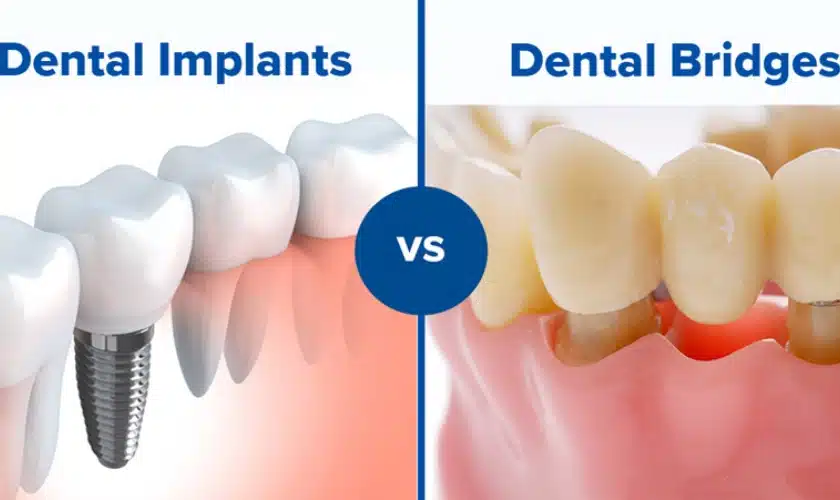How Dental Sense can Save You Time, Stress, and Money.
Table of ContentsExamine This Report about Dental SenseDental Sense Fundamentals ExplainedThe 10-Minute Rule for Dental SenseThe Only Guide for Dental Sense
are clinical devices surgically implanted right into the jaw to recover a person's ability to chew or their appearance. They offer assistance for artificial (phony) teeth, such as crowns, bridges, or dentures. When a tooth is lost as a result of injury or disease, an individual can experience problems such as quick bone loss, defective speech, or modifications to chewing patterns that lead to pain.Dental implant systems consist of an oral implant body and oral implant abutment and may likewise consist of a joint fixation screw. Dental implant vs bridge. The oral implant body is surgically placed in the jawbone instead of the tooth's origin. The dental implant joint is normally affixed to the dental implant body by the abutment addiction screw and extends with gum tissues into the mouth to support the affixed fabricated teeth
(https://sitereport.netcraft.com/?url=https://nearme.vip)Framework of The Dental Implant System selecting oral implants, talk with your dental service provider about the prospective benefits and risks, and whether you are a candidate for the procedure. Things to think about: Your general wellness is a crucial aspect in identifying whether you are a great prospect for dental implants, for how long it will take to heal, and just how long the dental implant may remain in location.
Cigarette smoking might influence the recovery process and decrease the long-lasting success of the implant. The healing procedure for the implant body may take numerous months or longer, during which time you usually have a short-term joint in location of the tooth. the dental implant procedure: Meticulously comply with the dental hygiene guidelines provided to you by your oral supplier.
3 Simple Techniques For Dental Sense
Implant failure can result in the need for an additional medical treatment to deal with or replace the implant system. Restores the ability to chew Brings back aesthetic appearance Assists maintain the jawbone from shrinking as a result of bone loss Protects the health and wellness of the surrounding bone and gum tissues Aids maintain adjacent (nearby) teeth steady Boosts high quality of life Damage to surrounding natural teeth during implant placement Injury to the surrounding tissues during surgical treatment, such as sinus perforation Injury throughout surgical procedure (as an example, crack of bordering jawbone) Inadequate feature, such as seeming like the teeth do not bite together generally An experience that the tooth is loosened or turning in place arising from a joint screw loosening Implant body failure (looseness of the implant body) due to systemic infection, which may be more most likely in clients with unrestrained diabetes mellitus because of regional infection in bone and periodontals sustaining the implant body as a result of delayed recovery, which might be most likely in patients who smoke Difficulty cleaning the gum tissues around the implant, causing bad oral health Neglected gum condition Post-surgical numbness as a result of nerve impingement or damages Constantly inform healthcare companies and imaging specialists that you have dental implants prior to any type of magnetic vibration imaging (MRI) or x-ray treatments.
FDA is not knowledgeable about any kind of negative events reported for MRI or x-ray procedures with dental implants. Oral implants systems are typically made of products that adhere to global agreement criteria of the International Organization for Standardization (ISO) or ASTM International. These standards have details of what makes a risk-free material.

A dental implant is a structure that changes a missing tooth. With screw-like gadgets, the surgeon inserts an implant right into the jawbone, and it functions as a support for a synthetic tooth, called a crown. A device called an abutment connects the man-made tooth to the oral implant. The crown is customized to fit the person's mouth and match the shade of their teeth.
What Does Dental Sense Do?
Some individuals are not eligible for oral implant surgery. It is for oral specialists to run on people with: acute illnessuncontrollable metabolic diseasebone or soft cells condition or infectionIf these problems are fixed, a person can have the surgical procedure. In, dental doctors avoid running on individuals with: If people with any of the above undertake dental implant surgical procedure, there is a higher danger of the implant falling short.

Oral read here dental implant surgical treatment is a personalized procedure. It's not the very same for every person. But the following provides a basic overview of what you can anticipate your dentist, oral specialist, periodontist or prosthodontist to do: Put the dental implant operatively. Offer you time to heal. Connect the post and last crown, bridge or denture.
Next, your specialist will meticulously put the oral implant into your jaw. Your cosmetic surgeon will certainly rearrange your gum tissues and close the laceration with stitches. If your implant is near the front of your mouth, your dentist will certainly make a temporary tooth for you to wear till you recover. This way, you won't have a void in your smile while you recoup.
Indicators on Dental Sense You Should Know
During the recovery phase, your jawbone should fuse to the dental implant. This process can take anywhere from 3 to 9 months.
As soon as your implant heals, your dental practitioner can connect the abutment (tiny adapter post) and your last repair (crown, bridge or denture). This usually takes about one hour to finish and may call for a second small surgery. You shouldn't really feel any kind of pain during your oral implant procedure because your service provider will use medicine to numb your gums.